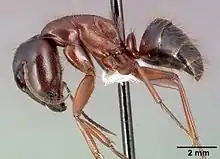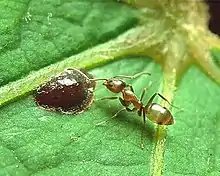Camponotus dumetorum
Camponotus dumetorum is a species of ant in the family Formicidae.[1][2][3][4] This species belongs to the genus Camponotus, which is native to North America. They are related to other species from the subgenus Tanaemyremex in western North America such as C. semitestaceus and C. vicinus.[5] C. dumetorum are primarily nocturnal and form undergrounds nests.[6][7] Like other select ant species native to California, their populations have been displaced with the introduction of Argentine ants.[8][9]
| Camponotus dumetorum | |
|---|---|
 | |
| Scientific classification | |
| Domain: | Eukaryota |
| Kingdom: | Animalia |
| Phylum: | Arthropoda |
| Class: | Insecta |
| Order: | Hymenoptera |
| Family: | Formicidae |
| Subfamily: | Formicinae |
| Tribe: | Camponotini |
| Genus: | Camponotus |
| Species: | C. dumetorum |
| Binomial name | |
| Camponotus dumetorum Wheeler, 1910 | |
Anatomy
Worker

Major
The average length of a major worker ant is 10–13 mm. They contain flattened lobes at the base of their scape. While the head and the gaster are black in coloration, the thorax and legs have a dull brown color. The clypeus is textured with piligerous punctures and this caste of workers is predominantly covered by hair (especially on the gaster).[5][7]
Minor
The average length of a worker minor is 6–9 mm. Other than a head that's more brown and shaped differently than that of the worker major, the only other distinct difference between a worker minor and worker major is a larger lobe at the base of the worker minors' scapes.[7]
Male
The average length of a male is 10–11 mm, and they share many of the same features as a male C. vicinus. However, their head appears less hairy, is reduced in length but greater in width, and have more visible frontal lobes at the base of the antennal scape. Their bodies are covered with stiff, yellow hairs and are generally dull in appearance with the exception of the gaster and legs.[5][7] Compared to C. semitesaceus, they have larger petioles and longer occiputs.[5] They are generally black in appearance with yellow wings.[7]
Distribution

Though C. dumetorum have been found in Baja California and California,[10] their distribution is concentrated in the California floristic province.[11] The presence of the non-native species L. humile, however, has displaced C. dumetorum and has consequently compromised their mutualistic relationship with other species.[8][9]
Ecological Impacts
C. dumetorum have been shown to have a facultative mutualistic relationship with Ferocactus viridescens by protecting the cactus from herbivores in exchange for extrafloral nectaries.[8] The use of C. dumetorum as a potential deterrent to imported fire ants via competitive displacement has also been explored.[6] Their potential candidacy is supported by the benefits they convey to the environment and to agriculture, and their larger size which may provide an advantage in outcompeting imported fire ants.[6]
References
- "Camponotus dumetorum Wheeler, 1910". www.gbif.org. Retrieved 2021-06-13.
- "Species Camponotus dumetorum". bugguide.net. Retrieved 2021-06-13.
- "Antweb". www.antweb.org. Retrieved 2021-06-13.
- "ITIS Standard Report Page: Camponotus dumetorum". www.itis.gov. Retrieved 2021-06-13.
- R., Snelling, Roy (1971). Studies on California ants. Los Angeles County Museum of Natural History. OCLC 8220172.
{{cite book}}: CS1 maint: multiple names: authors list (link) - Buren, William F. (March 1983). "Artificial Faunal Replacement for Imported Fire Ant Control". The Florida Entomologist. 66 (1): 93. doi:10.2307/3494555. ISSN 0015-4040.
- M., Wheeler, W. (2010). North american ants of the genus camponotus mayr. Nabu Press. ISBN 1-149-27353-4. OCLC 945909726.
{{cite book}}: CS1 maint: multiple names: authors list (link) - LUDKA, JOHN; LEVAN, KATHERINE E.; HOLWAY, DAVID A. (2015-04-16). "Infiltration of a facultative ant-plant mutualism by the introduced Argentine ant: effects on mutualist diversity and mutualism benefits". Ecological Entomology. 40 (4): 437–443. doi:10.1111/een.12206. ISSN 0307-6946.
- Holway, David A. (February 2005). "Edge effects of an invasive species across a natural ecological boundary". Biological Conservation. 121 (4): 561–567. doi:10.1016/j.biocon.2004.06.005. ISSN 0006-3207.
- Johnson, Robert; Ward, Philip (2002-08-01). "Biogeography and endemism of ants (Hymenoptera: Formicidae) in Baja California, Mexico: A first overview". Journal of Biogeography. 29: 1009–1026. doi:10.1046/j.1365-2699.2002.00746.x.
- Achury, Rafael; Holway, David A.; Suarez, Andrew V. (2021-01-12). "Pervasive and persistent effects of ant invasion and fragmentation on native ant assemblages". Ecology. 102 (3). doi:10.1002/ecy.3257. ISSN 0012-9658.
Further reading
- Bolton, B. (2016). "Catalogue of the Ants of the World" (PDF). unpublished communication. Retrieved 2019-07-02.